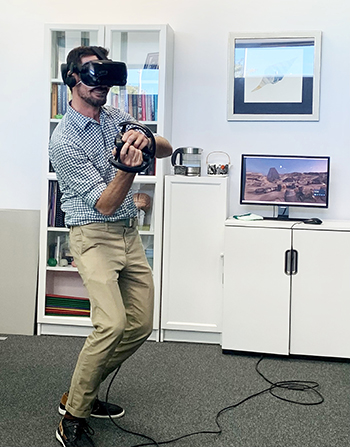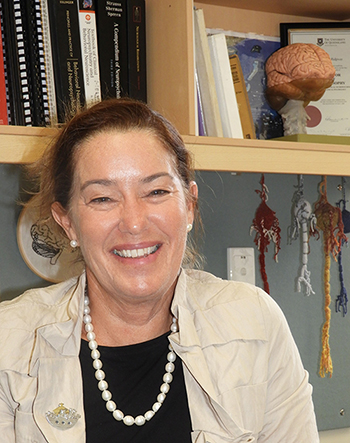It was not that he was a Top Gun pilot, or that he took us to live in amazing cultures, but I finally agreed that my father was cool when he arranged to let us sit in his Mirage jet training simulator. However, military training simulators were mere toddlers in the evolution of Virtual Reality.
History of Virtual Reality
The earliest reference to ‘VR’ is from a 1935 sci-fi novel Pygmalion’s Spectacles by Stanley Weinbaum in which a professor develops a pair of goggles so he can watch a movie with sight, sound, taste, smell, and touch. The idea became reality in 1957 when cinematographer Morton Heilig invented Sensorama, a multimedia theatre cabinet providing viewers with an interactive experience. The term Virtual Reality was not coined until 1987 by polymath Jaron Lanier’s headset and interactive gloves.
This topic quickly dates, but now VR is used for entertainment, training and in health for treatment of medical and psychological problems. It is the big video games companies that have the expertise, skills and resources to lead technological developments that education, the military and health sectors are now utilising. The push for VR stemmed from a desire to figure out where interactive entertainment was going next.

Just for fun, or therapeutic?
Yes it’s fun. Just ask Dr Jarrad if he enjoyed being Luke Skywalker!
For readers who haven’t experienced VR, put simply, it’s the difference between seeing a huge whale appear on your flat screen TV versus being (virtually) immersed underwater playing with fish and seeing a large whale swim up close to you. Or, how about Google street view on your laptop, versus walking (literally and virtually in your office) around the streets of Morocco or Paris, engaging most of your senses.
In my neuropsychology practice I have observed within-session changes in adults with neuropathic pain, functional movement disorders, and mental illness.
What about the generalisability of the gains to the real world? My impression is that education regarding pain management (somatic, psychological and social factors) is crucial, but that it is the immediate, highly salient experiential lesson gained during immersive VR experiences that demonstrates how we can override our brain’s perception of pain.
Case Summary 1.
Young male, ex-tradesman suffered a T5 complete spinal injury with a 2-year history of:
- Severe neuropathic pain - “It’s all day and night. Nothing makes it go away”,
- Depression- - “I only get occasional 20-second spikes of happiness”, and
- Social withdrawal.
In therapy he appeared interested in education regarding pain management (the somatic / psychological / and social factors) but had been highly resistant to trialling any distraction techniques or activities.
In a debrief following a trial of ‘The Blu’ (15 minutes of hyper-realistic, interactive, underwater VR experiences) he commented, “This is f… awesome. What is this thing? Is that really what it’s like underwater? I wanna do that”.
Then I asked him a final question, “How was your pain?”
He went very quiet and looked in complete shock and disbelief, then replied “I didn’t have any”.
This one-off immersive VR experience was a powerful reinforcer of the theory we had discussed. He agreed and followed through on trying novel activities (he did not desire to do more VR or any other digital gaming) in the community to manage his pain. One year on, he has continued to recover psychologically, is more engaged socially, his mood has improved and he uses multiple distraction activities to supplement his pain management medications.
Recent developments
A large research group at the University of Southern California with US Army funding brings film and game industry artists together with computer and social scientists to develop immersive environments for military training, health therapies, science education and more.
In Australia, several universities are partnering with government and private health, including University of Queensland, Griffith University, Flinders University, Monash Brain Park, Australian Catholic University, to research virtual reality for health-related training and interventions.
Show us your evidence!
There have been 91 Cochrane reviews conducted over the last 10 years with the search terms ‘’Virtual Reality Intervention’. The reviews cover topics of health and medical training, and interventions for a range of clinical disorders including stroke rehabilitation, multiple sclerosis, pain, serious mental illness, dementia, Parkinson’s, conversion disorders and more.
While most studies show some promising results with no adverse side effects, the technology is developing so quickly that there is insufficient data in matched conditions to draw firm conclusions. At a recent international neurological rehabilitation conference with a stream dedicated to VR interventions, none of the papers were using the advanced technology I utilise in my clinic rooms - such is the lag between study design, data collection and publication compared to the technical advances.
The primary modest but important findings across VR rehabilitation studies to date are that patients show more ‘interest in training’ and are more likely to engage in longer duration rehabilitation activities in VR compared to with an individual therapist.
One recent Cochrane review found that fully‐immersive virtual reality may reduce pain assessed by an observer based on children's behaviour (for example, crying, or rubbing a body part in a way that indicates pain) more effectively than non‐virtual distraction or no distraction (Lambert et al 2020).
The consensus across current studies is that more high‐quality research should be undertaken, and better evidence is required to make practice recommendations.
In the meantime, I explain the experimental nature of VR interventions to my patients with pain and functional neurological disorders and use pre, during and post monitoring of symptoms and video feedback. For individual patients getting immediate video feedback of the dramatic and obvious improvements in their pain experience or movement, pre-VR versus during-VR provides tangible confirmation to them that strong distraction can override their brain’s experience of pain or functional movement disorder and promote enjoyment and participation in activity beyond the VR environment.
Virtual Reality in Health
1995 saw the first research papers published describing VR to create immersive exposure environments for treating fears and phobias including a Virtual Vietnam program to treat PTSD.
There has been an explosion of commercial programs available to treat a dizzying array of fears and phobias and skills practice for relaxation and stress management. I look forward to the day these become standardised and we can refer our patients to specific programs with confidence in the research evidence. Equipment costs are coming down, access is improving, and there is a great future in using VR across health education for patients and health professionals to engage in interventions for a range of physical and psychological conditions.
Give it a try and encourage research.
|
Finally, Australia Day this year revealed a fantastic project by Brett Levey creating a virtual reality program to celebrate First Nations cultures. Check it out.
For more information see Functional Neurological Disorders - website https://fndaustralia.com.au/
















